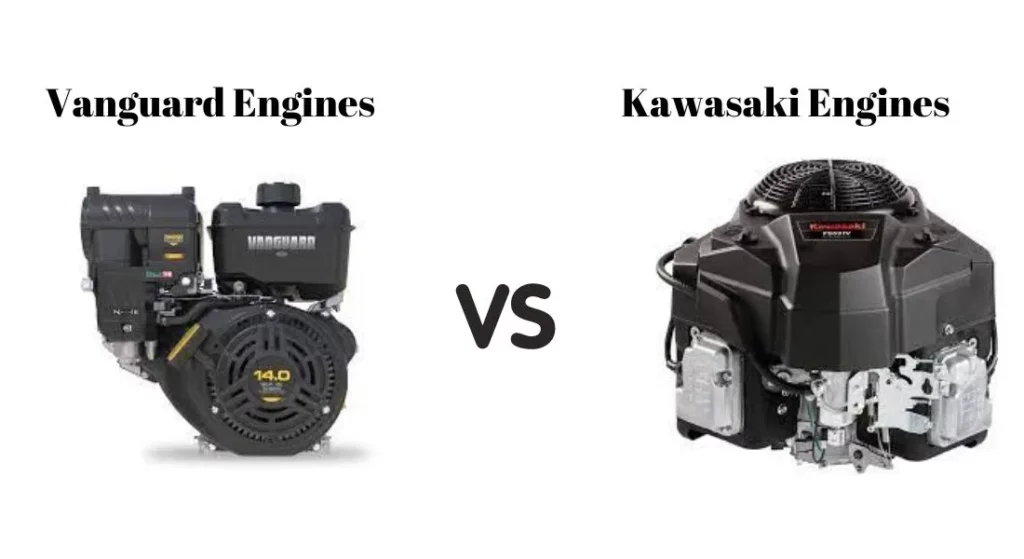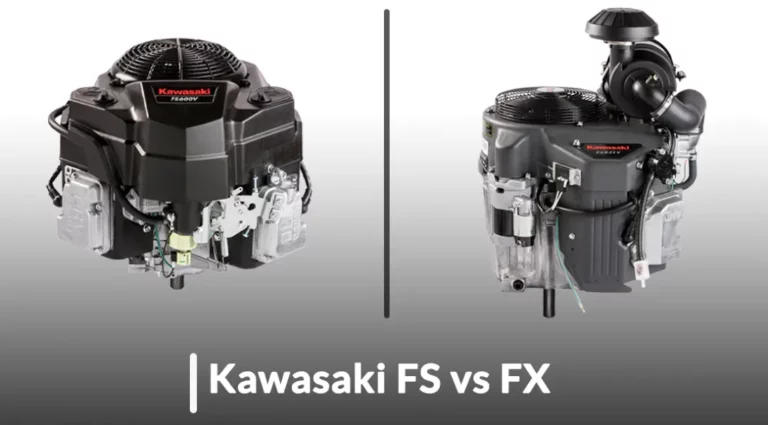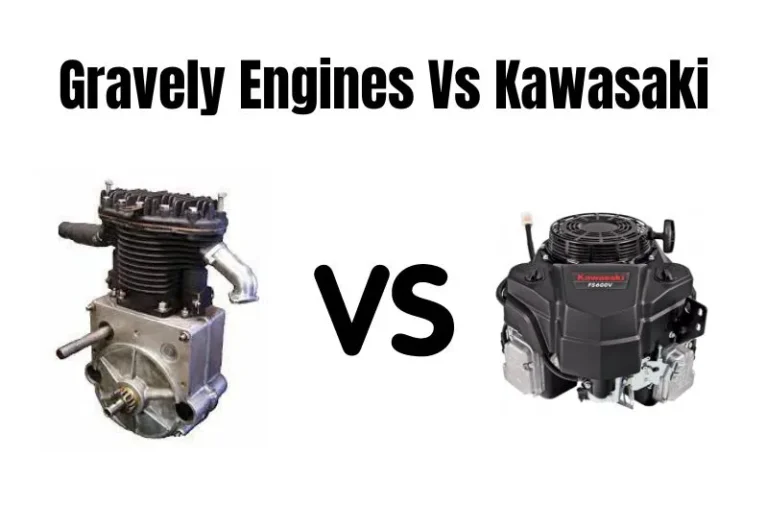Vanguard Engines vs Kawasaki Engines: The Ultimate Comparison
Vanguard® engines are built to maximize performance and are fueled by user feedback, while Kawasaki engines are known for their advanced technology, improved power, fuel efficiency, and quiet yet effective performance.
Engine types, power, fuel efficiency, performance, starter system, maintenance, warranty, and after-sale customer support are key factors in comparing them.
Thus, if you are bewildered to decide between vanguard engines vs Kawasaki engines, understanding their key distinctions will help you decide.
So, continue reading the article to learn more.

Quick Company Overviews
Vanguard:
Vanguard® Power Solutions is a leading power solutions provider with flexible manufacturing, vertical integration, and system expertise to help customers develop, innovate, and solve problems. The journey of Vanguard® Power Solutions started about 35 years ago with the development of a small block V-Twin in 1987.
The first large Vanguard® Big Block™ V-Twin engine was invented and introduced commercially in 2005. In 2010, Vanguard® came up with a new solution named the TransportGuard™ to prevent oil or fuel dilutions that leads to engine failure. Vanguard introduced its EFI and ETC technologies in 2014 to offer power solutions that can readily survive the harshest landscape conditions.
Kawasaki:
Shozo Kawasaki established the Kawasaki Tsukiji Shipyard in Tokyo in 1878, which was incorporated as Kawasaki Dockyard Co., Ltd. In 1894, the Sino-Japanese War began, and Kawasaki decided to take the company public. In 1897, Kawasaki Dockyard became a publicly traded company and built 80 new ships, including six steel ships such as the Tamamaru.
A new technique was adopted to harden the underwater foundation, and the dry dock was completed in 1902. Kawasaki Aircraft entered the small engine sector in 1956 with the KF4, the first general-purpose engine, and began sales in 1957. Check out this video to learn more about Kawasaki heavy industries.
What Are the Differences Between Vanguard vs Kawasaki Engines?
Check out the comparison of Vanguard and Kawasaki’s engines based on their shared characteristics_
1. Vanguard Engines Vs Kawasaki Starter System:
Vanguard® designs Engines with Electric and Recoil starter systems both.
Vanguard’s electric starter system is reliable and simple to use, even in freezing weather or after extended storage.
Its recoil starter system is ideal for backup in case of battery failure or other issues with the electric starter system.
Vanguard’s three-step starting procedure lowers pull force and has been tested to -29°C for simpler starting in all temperatures.
On the other hand, most Kawasaki Engines feature an electric starter, but some engine models like the Kawasaki® FS600V engine also offer recoil starter systems.
In the case of a battery failure or other issues with the electric starter system, the Kawasaki recoil starting system is ideal for backup.
2. Vanguard Engines Vs Kawasaki Power:
Things that show certain engines are more powerful than others _
- Cylinder Configuration:
Vanguard engines are typically available in V-twin and single-cylinder configurations.
The V-twin models have two cylinders arranged in a V shape, while the single-cylinder models like the Vanguard® 200 have just one cylinder.
Kawasaki engines come in single-cylinder, inline-4, and V-twin types with two cylinders placed in a V-shape. The single-cylinder models have just one cylinder, but the inline-4 models have four cylinders arranged in a straight line.
- Pistons and Piston rings:
Vanguard and Kawasaki engines both feature high-quality pistons and piston rings that are built to last.
Vanguard Engines use cast iron pistons with chrome-plated piston rings, while Kawasaki Engines use forged pistons with chrome-plated piston rings.
Forged pistons in Kawasaki engines can endure higher temperatures and pressures than cast pistons. They can bear more stress and last longer.
- Efficiency and Performance:
Vanguard and Kawasaki’s engines provide efficiency and dependability for a broader range of applications.
Vanguard equipment can operate on inclinations of up to 45 degrees, helping clients to get the job done.
Vanguard and Kawasaki Engines feature advanced combustion systems and integrated oil cooling to reduce heat and increase fuel efficiency.
Kawasaki is known for its V-TEC system, which allows precise valve timing for improved power, fuel efficiency, and emissions.
Kawasaki engines use high-performance camshafts to produce more power while consuming less fuel.
- Emissions:
Kawasaki engines employ high-efficiency combustion and air injection to decrease emissions. Contrarily, Vanguard engines use an advanced emissions control system that includes a catalytic muffler and a closed-loop fuel injection system.
So, both Vanguard and Kawasaki engines are built to meet or exceed emissions standards, with a focus on reducing harmful pollutants.
- Ignition System:
Vanguard engines use an ECM, high-energy coil, and spark plug for efficient combustion and consistent performance.
But Kawasaki engines use a digital ignition system and ECU to optimize spark timing and performance. It enhances combustion and ensures more power and fuel economy.
Related Post: The 5 Main Differences Between Gravely Engines Vs Kawasaki
3. Vanguard Vs Kawasaki Engines Fuel Efficiency:
Vanguard engines use an advanced combustion system with integrated oil cooling to reduce heat and increase fuel efficiency.
Its exclusive TransportGuard™ System saves oil waste, downtime, and decreased production by turning off the engine ignition and fuel supply at the same time.
Vanguard Engines come with different fuel systems, ranging from 3.3 gallons to 13.4 gallons.
On the other hand, Kawasaki engines feature a high-efficiency combustion chamber design and a dual-element air filter to improve performance and reduce emissions.
Fuel capacities range of Kawasaki is 3.6 gallons to 14.5 gallons.
The bottom line is that the Vanguard engines consume more fuel than the Kawasaki engines.
4. Vanguard Engines Vs Kawasaki Types & Ideal Application:
Vanguard and Kawasaki offer a range of engine types and displacements to suit different applications.
Vanguard Engines offer a range of models, including the Vanguard® 200, Vanguard® 400, Vanguard 810, and more.
Kawasaki Engines offer a range of models, including the FR series, FS series, FX series, and more.
Vanguard engines are popular for heavy-duty applications such as commercial mowing, landscaping, construction, agriculture, generators, pressure washers, and industrial equipment.
Kawasaki engines are known for their smooth operation, fuel efficiency, and low emissions, making them popular in outdoor power equipment and recreational vehicles.
Vanguard engines deliver high torque at low RPMs, while Kawasaki engines deliver high RPM power for high-performance applications.
5. Vanguard Engines Vs Kawasaki Maintenance, Warranty Service, & Customer Support:
Vanguard and Kawasaki’s engines are designed to be easy to maintain, with features such as automotive-style air filters and oil drain systems.
- Both offers reduce downtime and make it easier for users to keep their engines running smoothly.
- Vanguard engines come with a 3-year commercial or consumer warranty, which covers defects in materials and workmanship but not misuse or neglect.
- Kawasaki engines come with a 3-year commercial or consumer warranty for defects in materials and workmanship.
- Vanguard and Kawasaki have authorized service centers throughout the US where customers can take their engines for repairs and maintenance. But the availability may vary depending on location.
- On Vanguard engines, cyclonic air filtration allows for 600-hour air filter change intervals, lowering the total cost of ownership.
Pricing Comparison Between Vanguard Engines vs Kawasaki Engines
| Vanguard Models | Price | Kawasaki Models | Price |
| Vanguard 570cc Gas 18 HP Engine | ($1,699 – $1,799) | Kawasaki FT730V 26 HP Engine | $2,220.00 |
| Gas Engine 23 HP – Vanguard V-Twin, Horizontal Shaft | ($1,960 – $2,117) | Kawasaki FX921V®31 HP Vertical | ($3,044 – $3,178) |
| 18 HP Vanguard Engine | $2,049.99 | Kawasaki FS481V-S26 | ($1,528 – $1,807) |
| 23 HP Vanguard® Horizontal Engine | $2,199.00 | Kawasaki FD791D-S01 26HP Engine | ($3,479 – $3,682) |
Which Engine Is Better: Vanguard® or Kawasaki®?
Here’s a breakdown of the key differences between Vanguard® Engines & Kawasaki® Engines:
- Reliability: Vanguard engines are more rugged and built to last longer in harsh conditions. But Kawasaki engines are known for smooth operation and consistent performance.
- Power: Vanguard engines are better for heavy-duty applications due to their higher horsepower ratings and greater torque output. But Kawasaki engines are more fuel-efficient and emit less noise.
- Cost: Vanguard engines are more expensive due to their higher-quality materials and reputation for reliability and durability.
- Maintenance: Vanguard engines are easier to maintain due to their simple design. But Kawasaki engines require more specialized knowledge and tools.
Ultimately, the choice between Vanguard and Kawasaki engines varies on individual needs and applications. However, Vanguard is better suited for heavy-duty use, and Kawasaki is more suited for fuel efficiency and smooth running
Related Post: Kawasaki FS vs FX – Comparing Power, Performance, and Reliability and More
Frequently Asked Questions (FAQs)
Who makes Vanguard V-Twin engines For Mowers?
Briggs and Stratton make all Vanguard® V-Twin mower engines.
How long will a Kawasaki engine run?
A Kawasaki engine has a life expectancy of 3,500 hours, with oil change intervals of 50 hours. However, due to low compression, power begins to decline at 2,800.
How long will a Vanguard engine last?
Vanguard® Engines with 200-600 horsepower and load factors less than 30% can last up to 20,000 hours.
Are all Vanguard engines built in Japan?
Not all, but its V-Twin models are developed and manufactured from its Japanese production unit.
Related Posts:






